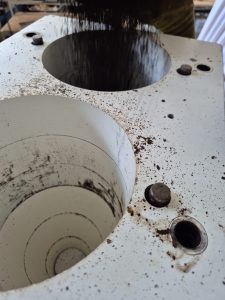
Corka by Zero Lighting
In an era where sustainability is no longer a design afterthought but a defining principle, Swedish lighting brand Zero continues to lead by example. Known for collaborating with forward-thinking designers, Zero champions innovation that balances form, function, and environmental responsibility. Their latest collaboration with British designer Samuel Wilkinson exemplifies this ethos perfectly.
When Zero Lighting approached Samuel Wilkinson to design a sustainable pendant, the brief was refreshingly ambitious: create a lighting novelty that could be “literally thrown into nature” and decompose naturally. From this directive, Corka was born – a compact conical pendant crafted entirely from cork.
Corka’s journey began in mid-2023 and was completed earlier this year, a remarkably swift turnaround for the design world. Having previously designed successful novelties for Zero Lighting, such as the Haze pendant and Thirty ceiling and wall lights, Wilkinson understood the company’s ethos and reputation for unique lighting fixtures with sustainability and high-quality at the forefront. Yet, bringing Corka to life demanded a deeply process-driven approach – one that involved extensive exploration of materials and manufacturing techniques before arriving at the final, refined form.
“We experimented with numerous materials before concluding to go ahead with cork. Learning about cork has been particularly interesting,” explains Wilkinson. “At first, we assumed turning cork on a lathe would be the most cost-effective approach. But some pieces oscillated during turning, making accuracy difficult. Switching to pressing methods produced more consistent forms with a finer surface finish.”
The buoyant, lightweight material is known for its unique impermeable qualities, making it an excellent thermal and acoustic insulator. This versatility allows it to be used in various applications, such as wine stoppers, building insulation, and now pendant lights.
Cork is a type of bark, specifically the outer bark of the cork oak tree, called Quercus suber. The material is harvested only every 12 to 14 years in the Montados, Mediterranean oak forests, due to being a vital player in supporting 325 animal and plant species, protecting from erosion, regulating the hydrological cycle, and absorbing carbon dioxide. This remarkable material is one of the most sustainable resources available due to its ability to naturally biodegrade without releasing any harmful toxins, as well as this, nearly all its byproducts can be utilised for products such as flooring, aggregates, or bioprocessed for cosmetics, pharmaceuticals, or water purification.

What sets Corka apart is not just its material but its method of production. While many sustainable lights rely on recycled composites or industrial processes, Corka reimagines a natural, centuries-old material through modern moulding techniques, achieving consistency without compromising the cork’s organic charm. The production of the pendant is deceptively simple yet deeply rooted in craftsmanship and material understanding. Each pendant begins with granulated cork – either natural cork, black cork, or a mix of the two – combined with a small amount of binder. This blend is carefully prepared to achieve the right balance between texture, density, and strength.
The mixture is then placed into two-part metal moulds made from Teflon-coated aluminium. The surface quality and pressure of these moulds are critical, initiating the natural binding reaction within the cork as it begins to set. Determining the precise treatment time is a matter of testing and refinement, as different cork combinations, particularly when mixing natural and black cork, react in subtly different ways.
 Once the mixture is sealed within the mould, it is left to cure for a carefully-timed period. During this stage, the cork reacts and binds, forming its distinctive, compact structure. When released from the mould, the Teflon coating leaves the surface with a soft sheen, a delicate contrast to the organic texture beneath. Each pendant is then lightly sanded by hand to reduce the gloss and reveal the raw, tactile quality of the cork. This gentle finishing exposes the material’s natural grain and variation, making every piece inherently unique. Though the process is efficient, it remains highly craft-based. As mentioned, no two pendants are identical; each reflects the subtle interplay of pressure, temperature, and time. “Once everything is added to the mould, the final result is out of our hands and left to the will of the cork,” says Wilkinson.
Once the mixture is sealed within the mould, it is left to cure for a carefully-timed period. During this stage, the cork reacts and binds, forming its distinctive, compact structure. When released from the mould, the Teflon coating leaves the surface with a soft sheen, a delicate contrast to the organic texture beneath. Each pendant is then lightly sanded by hand to reduce the gloss and reveal the raw, tactile quality of the cork. This gentle finishing exposes the material’s natural grain and variation, making every piece inherently unique. Though the process is efficient, it remains highly craft-based. As mentioned, no two pendants are identical; each reflects the subtle interplay of pressure, temperature, and time. “Once everything is added to the mould, the final result is out of our hands and left to the will of the cork,” says Wilkinson.
The creation of Corka occurred as a relatively streamlined development with few challenges and trials aside from the manufacturing process. Wilkinson had to work within the parameters of a strict budget set by Zero Lighting that ultimately heavily influenced the design process.
Wilkinson adds: “When machining from solid cork, the cost is directly affected by how many parts can be cut from a given sheet size, since the raw material is quite expensive. While tooling costs are much lower for machining, the outcome can be less consistent, so persuading Zero Lighting to invest in a moulding tool for the granular approach was important. The main criterion for the final shape was that it could be produced using a simple two-part male and female mould with sufficient draft angles to allow the part to release easily.”
Cork’s virtues extend beyond its renewability. It is extremely light – over 50% of its volume is air – and elastic, compressible without losing shape. It is impermeable to liquids and gases, thermally and acoustically insulating, fire-retardant, abrasion-resistant, hypoallergenic, and possesses a tactile natural texture that is warm to the touch. Its inherent qualities make it perfectly suited for a lighting object, softening the glow. 
“The tone and texture of the cork are among the material’s greatest qualities. They help to soften the emitted light, creating a warm and gentle glow. During the day, the natural gradient that forms across the conical surface is particularly beautiful, enhanced by the cork’s subtle granular texture,” adds Wilkinson.
Available in three finishes – natural, mixed, and black cork – and can be paired with either black or natural linen cables, with the linen option offering a lower environmental impact, similar to cork, completing a pendant that is entirely process-conscious and materially honest. Beyond its sustainable credentials, Corka offers a quiet sculptural presence to any interior, whether it is residential or commercial. Whether suspended singularly or as a cluster, the Corka offers a subtle, unique edge to any space through its tactile materiality and a soft ambient illumination, which evokes a sense of calmness through its natural warmth.
The mission was clear: to create a light that could quite literally be thrown back into nature. Wilkinson not only rose to the challenge set by Zero but also continues to demonstrate the possibilities of how organic material from the natural world can coexist harmoniously with contemporary design. Corka is more than just a pendant – it is a statement of intent in a world overrun by synthetics and overproduction. Together, Wilkinson and Zero Lighting champion a more regenerative, material-conscious future for lighting design.
Images: SW Studio, Zero Lighting



